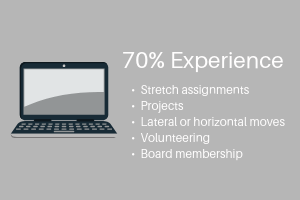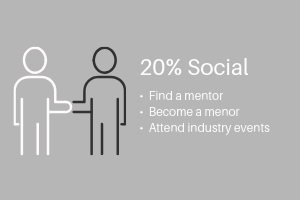Dedicating time to your development and growth is associated with many benefits – life satisfaction, increased competitiveness and adaptability, good health. But if you want to really succeed in your personal development and growth, what do you do?
Bill Gates, the founder of Microsoft, spends an entire week every year, alone in remote forest home, dedicating all of his time to reflecting, reading and learning.
Diya Jolly, Chief Product Officer at rapidly growing Okta, an identity management company, shares she accepted a pay cut and a lower title at three points in her career in order to build the skills to get where she is today.
Alister Esam, CEO of Process Bliss, acknowledges that what’s more important for a good CEO than past experience is their attitude towards learning. He dedicates one day every month on his personal development and growth.
Do you need to do all of that to succeed?
Not necessarily. But you need a robust plan to help you identify what you want YOUR personal development and growth journey to look like. Below, I walk you through the 3 steps to succeed in your personal development and never stop growing: (1) figure out what you need and want to achieve in your career, (2) figure out exactly the best way to do that, and (3) identify what barriers in your life may stop you and address these.
To make it even easier for you, I created a practical worksheet to help you identify your personal growth path. It provides you with a comprehensive framework making it easier for you to succeed. If you’re interested in using this worksheet as well, simply CLICK HERE and I’ll send it straight to your inbox!
This will also subscribe you to the Elegant Mind email list. But don’t worry! I’m not a spammer and the newsletter provides extra work and career tips as well!
 Identify what you want and need to learn
Identify what you want and need to learn
Having a clear vision what you want to achieve is the first step in putting your plan together. As young as 14-years old Arnold Schwarzenegger set his goal to move from his little home town in Austria to Hollywood. Whether you have a mind set on a specific goal, like Arnold, or you are just exploring opportunities, here are some steps to assess what skills and knowledge you need to develop.
External: How is your job/industry changing?
- Read industry trends reports – from the big consultancy companies (PwC, Deloitte etc) or from specialists in your niche.
- Register for Google Alerts for your sector – you can customise the frequency (daily, monthly etc).
- Consider if globalisation, technology, change in demand are likely to impact your industry – you may need to develop skills such as coding to stay abreast of these changes before they have happened; or do a stretch assignment to expand your responsibilities to other countries.
- Speak to experts in the field – whether at your company or outside. Besides being a great way to pick up on trends it’s also a wonderful conversation topic for your next networking event!
Internal: What are your personal interests and aspirations?
- Ask yourself how do your interests fit into the way you see your company or industry change in the future? Learning is more effective when it is aligned with your interests.
- Look at some recent job ads in your sector. Which ones appeal to you and what are the skills and knowledge required which you don’t currently possess?
- What are your values which you cannot compromise with? Whether that’s flexibility, financial security, creativity, etc, identifying these early will ensure you stay committed and are fulfilled when you reach your goals.
- What do your peers, stakeholders, clients, say are your strengths and blind spots? Some companies offer formal 360 Feedback but here are some great resources to do it yourself and gather feedback: resource 1 , resource 2 and resource 3
 Identify the best way to develop these skills and knowledge
Identify the best way to develop these skills and knowledge
Formal, structured learning may not cover everything the job entails. You’re also learning in someone else’s way. On the other hand, on the job training means we tend to do what we have done before. So a combination allows you to open up new possibilities, knowledge and skill areas. The 70-20-10 model is a popular framework to adopt.

- Don’t wait for your boss to challenge you. Ask them to take part in an upcoming project or pick up a task from them or a colleague.
- Actively seek lateral moves to same level, but different type roles, thus developing new ways of thinking, problem solving and adaptability – all among the 2019 most in demand soft skills.
- Volunteer to projects and boards outside of work – this is a great way to get exposure to new tasks and skills.

- Remember the field expert you discussed the future trends with? They are an excellent candidate for your mentor!
- Volunteer to be a mentor – this is a great way to develop your influencing, communication and leadership skills, regardless what level you are at.
- Network with people in your desired job. Find out what skills and knowledge they wish they had when they started. Diya Jolly herself found this insightful on her journey to becoming a product manager.

- Identify what your company offers – there’s often more than you realise!
- Ask for sponsoring your training – demonstrate the benefits to them such as productivity and performance; self-efficacy and team competitiveness. In the worst case, they say No but you have demonstrated your commitment to learning.
- On demand training is becoming more accessible. Some options are YouTube, podcasts, blogs, Coursera (all free) or Lynda.com, LinkedIn learning, (paid; <$30p/m). You can also explore short courses in your city or local university.
 Identify and address barriers
Identify and address barriers
Internal or external barriers may hold back your progress and cause you to give up. Identify these as well as ways to address them. Here are some examples:
Learning is not attained by chance. It must be sought for with ardor and attended to with diligence.
Abigail Adams, Former First Lady
#1 Lack of time
The number 1 reason employees say holds them back from spending time on their development is lack of time.
- Start small! Pledge to spend as little as 15-20 minutes every week. You can then gradually increase that when it’s already formed as a habit.
- Assess how you’re spending your time. For example, skipping your lunch break is a bad work habit many of us have. But you can use this time to listen to a podcast instead, or network with the right people. Bill Gates spends a full week every year, alone in a forest, reading, learning and reflecting. If he can find the time so can you!
#2 Keeping Momentum
We start strong but as committed as we are, competing priorities such as childcare or day to day work may take over.
- Ritualise it – commit to a specific day and time and do not compromise on it! Arnold Schwarzenegger ritualised and did not compromise on his workout routine on his journey to Olimpia!
- Set smaller goals so that you continue to see the benefit and rewards for your efforts on a regular basis.
#3 Losing interest
You need to see some value and reward in order to sustain your effort.
- You may be required to learn something at work to fulfill a formal authority request, for licencing purposes etc. Understand how it will benefit you and your career so that it is not so daunting.
- Write down a clear and detailed vision for yourself and refer back to it. When Bill Gates and Paul Allen (his partner) started Microsoft they had a clear vision of a computer in every office and home. And this vision remained clear and brought Microsoft where it is today.
Jim Rohn, Entrepreneur and Motivational Speaker says:
“Learning is the beginning of wealth, health and spirituality. Searching and learning is where the miracle process all begins.”
So get in the driver seat of your personal development and growth by downloading your FREE worksheet and Plan.















What do you think?